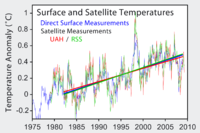
Photo from wikipedia
Thermal infrared spectra acquired by Cassini/Composite InfraRed Spectrometer (CIRS) in limb-viewing geometry in 2015 are used to derive 2-D latitude-pressure temperature and thermal wind maps. These maps are used to… Click to show full abstract
Thermal infrared spectra acquired by Cassini/Composite InfraRed Spectrometer (CIRS) in limb-viewing geometry in 2015 are used to derive 2-D latitude-pressure temperature and thermal wind maps. These maps are used to study the vertical structure and evolution of Saturn’s equatorial oscillation (SEO), a dynamical phenomenon presenting similarities with the Earth’s quasi-biennal oscillation (QBO) and semi-annual oscillation (SAO). We report that a new local wind maximum has appeared in 2015 in the upper stratosphere and derive the descent rates of other wind extrema through time. The phase of the oscillation observed in 2015, as compared to 2005 and 2010, remains consistent with a ∼15 year period. The SEO does not propagate downward at a regular rate but exhibits faster descent rate in the upper stratosphere, combined with a greater vertical wind shear, compared to the lower stratosphere. Within the framework of a QBO-type oscillation, we estimate the absorbed wave momentum flux in the stratosphere to be on the order of ∼7 × 10−6 N m−2. On Earth, interactions between vertically propagating waves (both planetary and mesoscale) and the mean zonal flow drive the QBO and SAO. To broaden our knowledge on waves potentially driving Saturn’s equatorial oscillation, we searched for thermal signatures of planetary waves in the tropical stratosphere using CIRS nadir spectra. Temperature anomalies of amplitude 1–4 K and zonal wave numbers 1 to 9 are frequently observed, and an equatorial Rossby (n = 1) wave of zonal wave number 3 is tentatively identified in November 2009. Plain Language Summary Two aspects of tropical dynamics in Saturn’s stratosphere are addressed: (1) the evolution, between 2005 and 2015, of an equatorial periodic oscillation in temperature and thermal wind and (2) the activity of planetary-scale waves. To do this, we analyze infrared spectra acquired by the Composite InfraRed Spectrometer instrument on board the Cassini spacecraft. These spectra are used to map Saturn’s stratospheric temperature to identify the signature of waves and follow the evolution of the vertical structure of Saturn’s equatorial oscillation. The latter is a dynamical phenomenon analogous to the Earth’s quasi-biennal oscillation, semi-annual oscillation, and Jupiter’s quasi-quadriennal oscillation and hence represents a unique case study of comparative planetology. These oscillations are thought to be driven by interactions between upward propagating waves and the mean zonal flow. We find that the phase of Saturn’s oscillation in 2015 remains consistent with a period of 15 Earth years (half a Saturn year) and derive estimates of the momentum flux absorbed by waves. We report the observation of wave signatures with zonal wave numbers 1 to 9, among which an equatorial Rossby (n = 1) wave of zonal wave number 3. Altogether, these observations bring new constraints to future numerical models aiming at understanding Saturn’s tropical dynamics.
Journal Title: Journal of Geophysical Research
Year Published: 2018
Link to full text (if available)
Share on Social Media: Sign Up to like & get
recommendations!